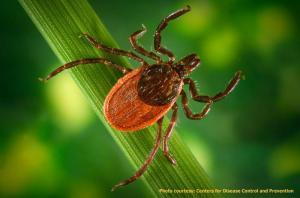Preventing Ticks
- posted: May 10, 2016

Ticks! How to Prevent Those Icky Arachnids from Harming Your Pets
According to a recent news reports, due to the relatively warm winter, we can expect to see large numbers of ticks this season in York County and surrounding areas. Ticks are members of the arachnid family which also includes spiders and scorpions. Tick bites in and of themselves are not so concerning, though the bites can become irritated or infected. It is the many number of bacterial infections that ticks carry and transmit that makes them potentially dangerous to us and to our pets.
Of course, Lyme disease is probably the number one threat in South Central Pennsylvania. Lyme disease can cause fever, lameness and sore joints and, in rare cases, damage to the kidneys. Other diseases carried by ticks include anaplasmosis and ehrlichiosis. Cats are relatively resistant to tick-borne illnesses but can fall ill from a feline-only disease called cytauxzoonosis or bobcat fever. This illness causes lethargy, anemia and fever and is often fatal. This disease is more common in the southeastern United States but is occasionally found in Pennsylvania. Ticks will also feed on not just mammals, but also on birds, reptiles and amphibians.
Ticks typically live in wooded areas, but can be found in urban and suburban areas as well. They hang out in tall grass along tree lines but do not actually live in the trees. When people or animals walk by, the ticks move to the end of a grass blade and wave their legs in a gesture known as “questing” and climb aboard a host to feed. The tick will find a prime spot then bite and attach to the skin where it will engorge with blood then detach and fall off. Ticks may remain attached to a host for up to five days!
If you find a tick attached to your pet, the best way to remove it is to grasp the tick close to the pet’s body using a tissue or paper towel or using tweezers and firmly pull it off. Try not to touch the tick with your bare hands. If the head does not come out, don’t panic. The head will eventually be expelled and will not cause any problems. Just watch the area for signs of infection.
There are several ways to prevent tick bites: check yourself and your pets for ticks after walking in any wooded areas and immediately remove any found loose or attached and use a repellent like DEET on yourself and a good quality flea and tick preventative on your pet. USE CAUTION WHEN PURCHASING AND APPLYING TICK PREVENTATIVES FOR CATS! Cats can have serious and even deadly reactions to permethrin and pyrethrin products. Please do not ever use a product that is not specifically labeled for cats on your cat. Topical products containing the active ingredient fipronil are effective and safe for preventing ticks in cats, but may no longer be very effective against ticks. Dogs can also receive a vaccine to help protect them against Lyme disease.
Don’t panic if you find a tick on your pet, but do monitor your dog or cat for signs of illness for several weeks after removing the tick, and see your veterinarian if you think your pet may be sick. Diligent tick checks and use of quality tick preventatives are effective ways of preventing your pet from being bitten by ticks. Ask us about topical Vectra 3D, chewable Bravecto and other options to keep your pets safe this summer!
This blog brought to you by the Patton Veterinary Hospital serving Red Lion, York and the surrounding communities.
Location
Patton Veterinary Hospital
425 E Broadway
Red Lion, PA 17356
